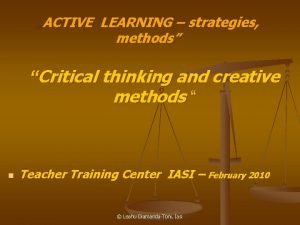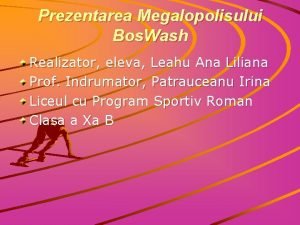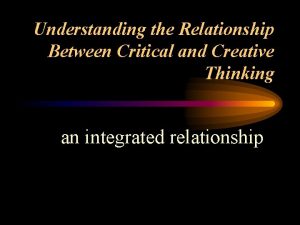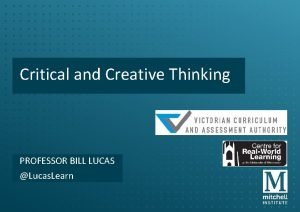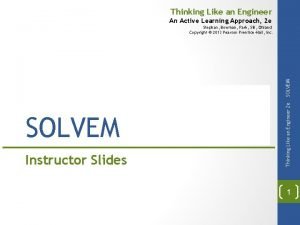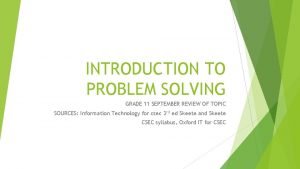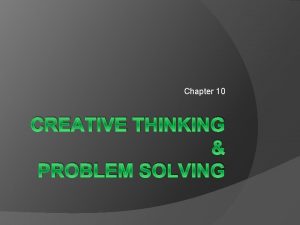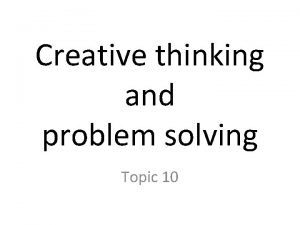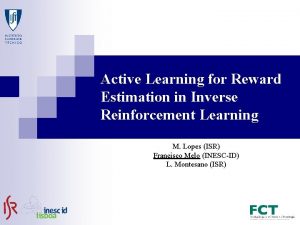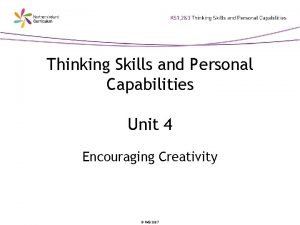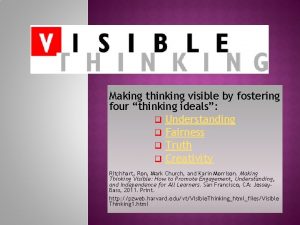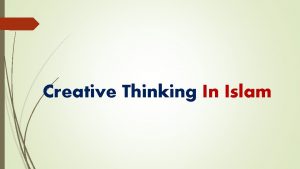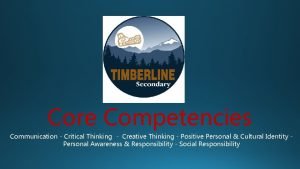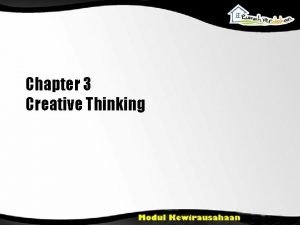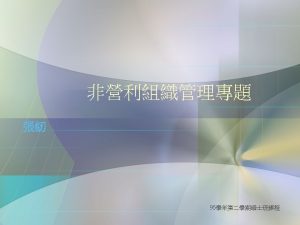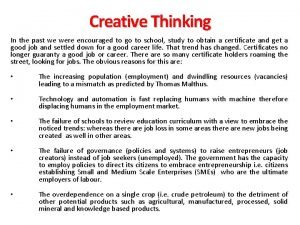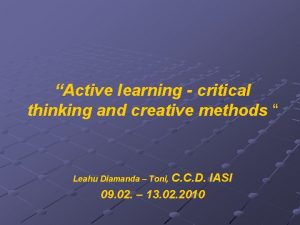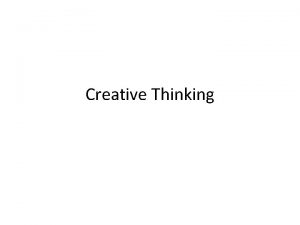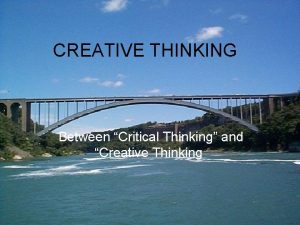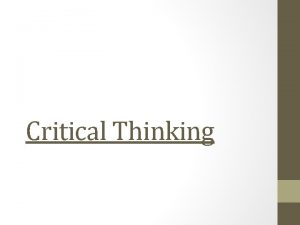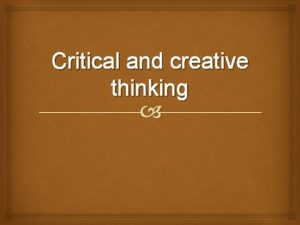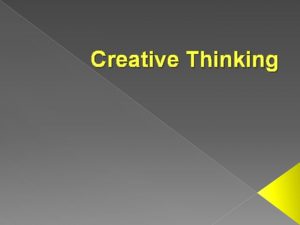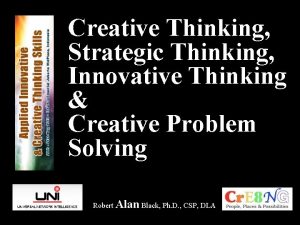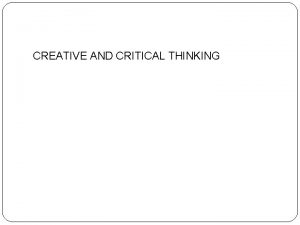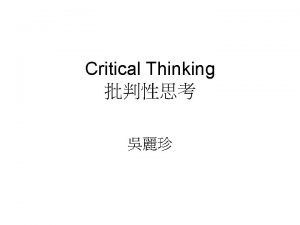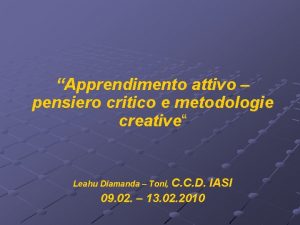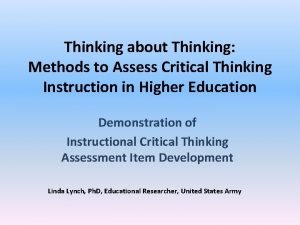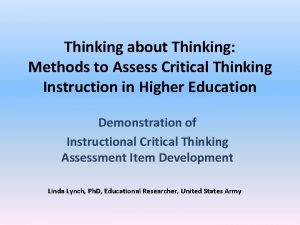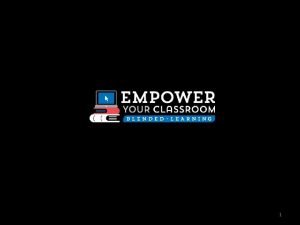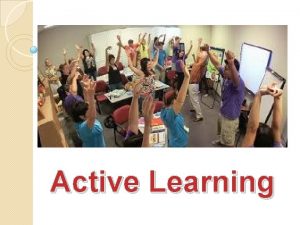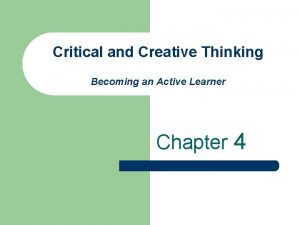Active learning critical thinking and creative methods Leahu
























- Slides: 24

“Active learning - critical thinking and creative methods “ Leahu Diamanda – Toni, C. C. D. 09. 02. – 13. 02. 2010 IASI

Protocol - Be punctual! Mutual respect Be an active listener! Do not interrupt the speaker? Respect the time for your intervention / task! Be tolerant! If you have a question, ask it! Ask for an example if the task is not clear to you! Be skeptical, do not accept everything you hear! Criticize the idea, not the speaker! Argue when you disagree! Propose alternatives! Signs agreed: left hand - silence, right hand – ask the permission to speak

CT (Bloom): involves - analysis, synthesis, evaluation based on criteria and values - assumed by individuals and practiced with skill and efficiency. CT does not mean "attack the person”. CT is one way to address and solve problems based on convincing, coherent-logical, rational arguments. To think critically does not necessarily have a negative, impractical, ineffective position! Criticism can be: - constructive, with the aim of substantiation and foundation of opinion; of rational argumentation, of acceptance - destructive, with the purpose of demolition, an attempt to justify what is difficult (or nearly impossible) to be justified and accepted (by all).

Cooperative Learning Roles The timer - ensures that the group focuses on the task and the work to be conducted within the time set The active listener - gets ideas from all group members and repeats or reorders what the others have said The person in charge with the materials –distributes and collects the necessary materials for the group The reader -reads the materials for the group The reporter - exhibits the conclusions in front of the class NOTE: The students should change roles during every activity

Framework for thinking and learning Evocation - It requires students to brainstorm and compile lists of what they know or believe that they know, as a starting point (individually, in pairs and / or group). - Someone writes the group ideas on the board, accepting them all The role of the teacher is to guide, underline the main ideas, and listen carefully to the students. 1. What is the subject? (identify) 2. What you know about that? (write on the board) 3. What do you want to know about that? (write on the board) 4. Why do you find these informations?

Making sense Learning Phase The student comes into contact with a new content (reading of texts, watching a movie, listening to lectures) Grasping meaning is done by each student as they search for information that would confirm their predictions. Teacher: - doesn’t influence students - supports the efforts of the students in monitoring their understanding

Reflection Students: - are reinforcing their knowledge actively and restructure the scheme to include their new information; -by acquiring the real knowledge, sustainable learning takes place 1. What did you learn? (largest possible answers) 2. Ask questions to extract important information not mentioned in the evocation stage. 3. In response to their answers, ask: "Why do you think that? "

Evocation (for the next segment of content) What else do you think you will find out? What haven’t you find out from what you would like to know? Why is this important? Why do you think that? (Boost discussion and add information to the ones already written on the blackboard. )

Brainstorming (a creative way of thinking) Generates ideas No evaluation Time limited Read ideas / keywords aloud Clarify ideas Repeat the process Evaluate the ideas (select the best)

SINELG - Interactive Grading System for Streamlining Reading and Thinking Method steps : Write everything you know/ you think you know about. . . (3 -5 min) Say what you know about. . . (write down ideas) Read the text and put signs on the article: “√” - if you read something that confirms what you knew / you thought you know “-” - if you read a piece of information that contradicts / differs from what you knew / you thought you know “+” - if a read piece of information is new to you “? ” - if you find information that seem confusing to you or if you want to know more about this

Short break (think 2 -3 minutes) Resume the list of what you already know, discuss in pairs about knowledge confirmed and dispelled Draw up a table SINELG individually, then in pairs (15 min) √ + - ? Ideas in class discussion on questions (10 min) The need to indicate other sources of information

I KNOW/ I WANT TO KNOW/ I’VE LEARNT (Ogle, 1986) Evocation (Brain storm info) The students work in pairs and make a list with everything they know about the new subject Make up on the board/ notebook a chart and you fill in column 1 I know What do I think I know? I want to know What do I want to know? I’ve learnt What have I learnt? They make up questions to which the answers are going to be given in the lesson (column 2) Comprehension techniques They read the text/ attend a lecture/ a didactic movie Reflection The Ogle pattern is being repeated and the students decide what they have learnt by filling in column 3 Some questions can have no answer or there may appear new ones The students who know answer, the teacher or information sources are being given

The method: „THE GRAPE” Write a word or a key sentence in the middle of a page Start to write words/expressions that come to your mind related to the given subject Start to draw lines between the connecting ideas Write as many ideas as come to your mind until time is off or you have nothing else to say Basic rules Write everything that comes to your mind Don’t evaluate your ideas, just write them down Don’t bother about punctuation, spelling or other rules of the written text Don’t stop writing until enough time has passed If the ideas refuse o come, insist upon the paper and in the end they’ll show up Allow several connections to come up. Don’t limit the number of ideas and connexions.

The method: „The Venn Diagram” It is made up of two large circles partially juxtaposed It is used to show the resemblances and the differences between two ideas, concepts or characters If the students compare the journey of Columbus with that of Marco Polo, the diagram allows to point out the differences between the two events, showing at the same time the common elements The students working in pairs fill in just one circle, which refers to one of the two explorers They can come in groups of four to compare their circles, filling in the common area of the circles.

The method: „ The gallery tour’ In groups of three or four, the students first work on a problem that can become a final product (a diagram, a chart, a grape) The products are being exhibited on the walls of the classroom At the teacher’s sign, the groups go round the classroom to examine and discuss each product (10 minutes) They can take notes and write comments on the exhibited papers After the gallery tour, the groups reexamine their own products by comparison with the others and read the comments written on their product (10 minutes)

The method: „The quintet” The aim: to shape the ability of resuming the information, to grasp the complexity of ideas, feeling and convictions. A five verse poem, with a clear presentation of the ideas which express opinions upon the given subject Time: 5 - 7 minutes The students work first on the individual draft, then in pairs, they rewrite a final quintet which they read in the class Instructions Line 1: one word-the title (describes the subject) Line 2: two adjectives ( description) Line 3: three gerund verbs which express actions ( action) Line 4 : four words which express the feelings towards the subject Line 5: a word which expresses the essence of the subject

Selfevaluation in using the activity directed by reading and thought Always 1. 2. 3. 4. 5. I make predictions based on the titles and photos I guess what’s going to happen based on the type of the story When I read I think at my predictions I pay attention to the details that can help me to make new predictions Even when I read something else I stop and wonder if I already know what’s going on next Sometimes Never

Group self-monitoring Group self-evaluation for discussions Almost always Sometimes Never 1. We check if we have understood very well what we have to do 2. We follow our tasks 3. Each of us contributes with opinions 4. Each of us listens to the end before answering 5. We express several opinions before reaching conclusions 6. In the end we round up our conclusions 7. One of us takes detailed notes of our discussion.

The Portfolio *A “pact” between the student and the teacher which should help the student in the process of self-evaluation * At the beginning of the period we discuss what the student must know/ must do during the whole process of learning * We diagnose the learning needs of the students in order to establish the evaluation objectives and their criteria; we discuss with the students involved in the evaluation process. *The presentation/introductory one: the selection of the most valued products *The progress/working one : all the elements on display in activity *The evaluation one: the objectives, the strategies and the instruments of evaluation, the result charts.

The Structure of the Student’s Portfolio The summary The argument (the works included and their importance) Summaries of the studied literary works Essays on different topics suggested by the teacher, adapted to the age and the student’s interests Articles, commentaries on different books/articles of criticism Individual worksheets Individual/group projects Current home assignments Term tests Drawings which illustrate scenes from literature or just possible illustrations ( for students with visual abilities) Charts/graphic representations for connections between genres , literary species, current works/literary movements, narrative processes (for students with logical-mathematical intelligence) Recordings, photos from individual/group activities (museum visits, memorial houses, trips, movies after famous books, shows) Definitions of the operational concepts of the national programmes Interviews with different personalities of the cultural/literary life Supplementary commentaries/evaluations of the teacher or group colleagues.

The Portfolio Evaluation criteria items Yes Partially No Observations 1. Presentation - a clear evolution in comparison with the previous presentation - completeness - general layout 2. Summaries - the quality of the paperwork - the coordination with the given subject - the quantity of the final products 3. Practical workshops -adequate target -the efficiency of the working method - individual/group work 4. The student’s opinions on different parts of the portfolio - reflections upon his own work - reflections upon group w - the student’s expectations from the ongoing activity.

5)Chronology - ordering the materials according to their chronological status 6) Self-evaluation - self-evaluation of the performed activities - the coordination between target and result - the registered progress - the grade he thinks he is entitled to 7) Other materials - their quality - their relevance to the proposed theme - their importance to raising appraisal

The Group Portfolio The Cover ( it reflects in a creative way the group’s personality) The contents The introduction of the group and its members The introduction and the argumentation of the chosen samples Samples which have required the joint effort of the group members Observations of the group members according to the way they interacted during common activities Self-evaluation of the members and their own group evaluation Individual samples changed upon the received feed-back from the group ( essays, final products) Self-evaluation of the members regarding the qualities and weak points of the social interaction The way they have raised group awareness and helped other colleagues to learn The list of the future learning targets and social behavior which the group members establish Commentaries and feed-back from the teachers, Methodists and other study groups.

GOOD LUCK!
 Perbedaan critical thinking dan creative thinking
Perbedaan critical thinking dan creative thinking Active learning strategies to promote critical thinking
Active learning strategies to promote critical thinking Active learning strategies to promote critical thinking
Active learning strategies to promote critical thinking Megalopolis boswash
Megalopolis boswash Relationship between critical and creative thinking
Relationship between critical and creative thinking Critical and creative thinking victorian curriculum
Critical and creative thinking victorian curriculum Bill lucas creativity wheel
Bill lucas creativity wheel Critical semi critical and non critical instruments
Critical semi critical and non critical instruments Spaulding classification of medical devices ppt
Spaulding classification of medical devices ppt Critical reading active
Critical reading active Thinking like an engineer: an active learning approach
Thinking like an engineer: an active learning approach Creative thinking and problem solving grade 11
Creative thinking and problem solving grade 11 Segg gegs gges egsg
Segg gegs gges egsg Creative thinking and problem solving grade 10
Creative thinking and problem solving grade 10 Active and passive learners
Active and passive learners Active learning reinforcement learning
Active learning reinforcement learning Icedip
Icedip Creative hunt thinking routine
Creative hunt thinking routine Creative thinking in quran
Creative thinking in quran Stuntnastics
Stuntnastics Talents unlimited
Talents unlimited Contoh scumps
Contoh scumps Creative thinking wikipedia
Creative thinking wikipedia Creative thinking
Creative thinking Critical thinking chapter 2
Critical thinking chapter 2


